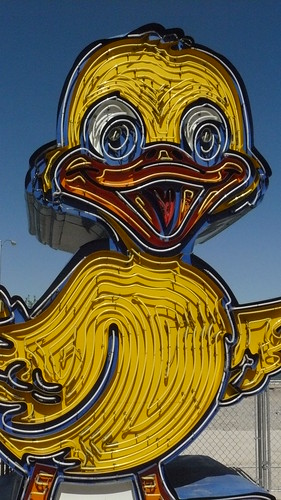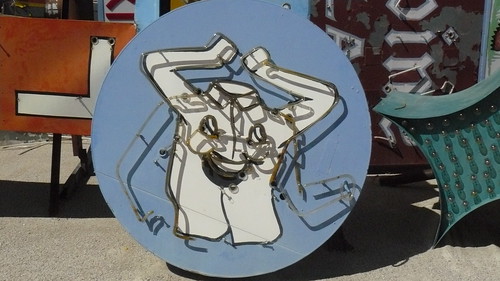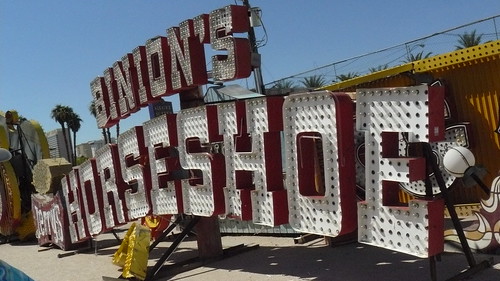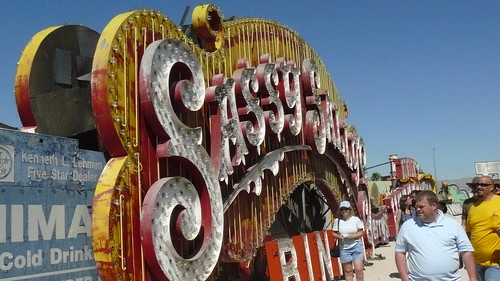On our road trip in the US last summer, one of must-sees on the itinerary was the Neon Boneyard in Las Vegas. Not being much of a gambler or glitzy show watcher, I had to find alternatives for our visit to Sin City and this seemed a great way to learn a bit more about the history of the place and see just what the predecessors of the MGM Grand and New York New York looked like. And of course, the signs being so important to draw the tourists in off the Strip, they were fantastic pieces of work.
The Neon Museum
There are great plans for this museum. The planned visitors’ centre will be housed in the La Concha motel lobby, removed in bits from the Strip and reconstituted beside the boneyard itself. It’s a beautiful curved white building and will be stunning and otherworldly when it’s fully restored.
The museum has already restored some of the old neon signs, and you can take a self-guided tour of ten of those in the Fremont Street area. Many of the rest will be restored and mounted along Las Vegas Boulevard, which will be a fantastic sight, and others are probably just too far gone. Even these may turn out to be useful, though, as there’s a plan for an entrance sign made up of lettering from more than one sign.
The museum is a fantastic organisation who have done a great job so far saving neon signs that are no longer viable – lcd and led signs are much cheaper to make and run and can be seen during the day. And they keep the history of Las Vegas alive, in a city which mostly obliterates and builds over its past.
Neon Boneyard Signs
Here are some of the stories behind the signs:
Ugly Duckling car sales was a franchise that specialised in selling cars to those who would otherwise have difficulties finding finance to do this. The franchise has since closed down, and the company has now changed their name to DriveTime. Hence no more Mr Ducky. I’m not entirely sure in whose view this duckling is ugly, mind you! There’s a view of the sign in situ on this great web page
I haven’t been able to find out anything about the company behind this sign. As you can see, however, the design of the sign means that in the dark you would have a cute animated shirt waving its arms about!
Benny Binion was a convicted murderer and mobster and came to Vegas in 1946. His Horseshoe casino was popular due to the high limits for bets. And he was the first to get rid of the sawdust on the floors and bring in plush carpets and free drinks for patrons.
The Lido de Paris girls arrived in Vegas in 1958. There’s a great photo of them scoffing hot dogs on this Early Vegas page. According to that site “The Lido Girls set a Las Vegas trend, followed by the Beauties of Japan, Hawaii, the South Pacific, the Mambo Showgirls of Havana and the Carnival Women of Brazil.” The Lido was replaced by a new show, Enter the Night, in 1992.
Sassy Sally’s was a strip joint. The sign showing Sassy Sally herself, wife of Vegas Vic (they were actually married by a Vegas minister) is back up in Fremont Street and part of the Neon Museum self guided tour (along with Vegas Vic). (Photos of both of them here.
Sally’s leg no longer kicks up (I’ve read that it never did work, really) and Vic’s arm no longer moves.
Neon Museum Details
You must register for their tour – they run twice a day Tuesday to Saturday at the moment. Full information on how to do this can be found on the Neon Museum website.
The museum is situated about 20-25 minutes’ walk from Fremont Street. Bear this in mind if you’re planning on walking on a hot day, and think about taking the taxi or car instead. Take plenty of water as you’re out in the open. Until the visitor centre opens, there are no toilets available – but there is a handy public library across the street if you’re desperate!

Born in Belfast and now living in London, Julie McNamee is involved in internet marketing as a day job and blogging as a hobby. She’s interested in all things quirky and Fortean, as well as art, photography and theatre. Her blog Quirky Travel, specializes in London and Paris top tips and off the beaten path information with subjects such as London film locations and unusual Paris museums.














